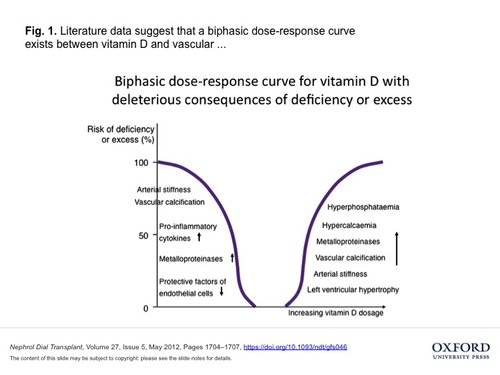Vitamin D - Complex Issues for Proper Dosage
 Friday, May 13, 2016 at 9:37PM
Friday, May 13, 2016 at 9:37PM Scientists have discovered over 30 forms for various vitamin D generated compounds. While it might be assumed that nature would take the proper course for these breakdown D elements and keep them in balance, that is definitely not the case, just like with estrogen. Many altered genes could be involved in Vitamin D metabolism. There is perhaps as much as 5% of the human gene genome that is regulated by and involved with vitamin D hormone form. 
Some of these cascading compounds built as vitamin D breaks down are involved in immune functions and such disease processes as infection fighting and even involvement in numerous cancers. Nature also provided that some of these elements would be the limiting factor to speed the destruction and elimination of the active hormone form of vitamin D called calcitriol, 1,25(OH)2D3, plus the storage D form listed as 25-OHD. Nature often uses a downstream produced element as an indicator that the preceding nutrient has done it's job and it is now time to destroy that element form and limit further actions. Calcitriol lasts only hours in the body while 25-OHD up to 15 days, and some vitamin D precursors for months, especially if stored in fat cells. This fat storage aspect is why larger people need to consume slightly greater amounts of vitamin D compared to underweight or regular weight people to get the same blood level increases.
Then remember, many vitamin D forms react and turn on vitamin D receptor sites on cell walls, even on cancer cells. Add to this process that about half of the vitamin D forms can attach to Vitamin D Binding Protein which acts as a time release mechanism for the various vitamin D forms. When attached, they are evidently not available for biological actions at that moment, according to one theory that explains quite a few observed actions unexplainable without this theory. Are you beginning to see how complex an issue it is to arrive at proper dosages?
A study looked at holding people at different D levels over the winter months when vitamin D levels typically drop from less sun exposure. Amounts needed to hold were between 600 IUs to 1600 IUs. The exact healthy level of vitamin D as 25-OHD is still a matter of debate. But, it is probably somewhere between 25-35 ng/mL or 65 to 85 nmol/L. To convert ng to nmol, multiple ng by 2.5. Plus remember, the 2 forms 25-OHD and 1,25(OH)2D are not exactly equally connected. As on goes up, the other does not automatically follow. You can have one high and the other low, or vice versa.
Many disease states also generate differences in these levels to compound the issue. Cancer cells either develop a mechanism or cause an enzyme to speed the breakdown and elimination of 1,25(OH)2D, the calcitriol hormone form of vitamin D, and prevent calcitonin, the 25-OHD storage form, from producing more hormone vitamin D. 1,25(OH)2D has anti-cancer properties and has been used for this purpose, but because it also increases calcium uptake, this eventually leads to a negative side effect. Analogs of calcitriol were developed to try to mitigate this calcium increasing effect while maintaining the cancer fighting aspects.
Many enzymes are involved in the Vitamin D compound breakdown forms. These enzymes are one area that controls how vitamin D compounds are produced, plus how they function and regulate each other.
WRAP UP
Scientists like to look at just single aspects of a nutrient to produce effects in only one area like vitamin D on bone health. But vitamin D also impacts immune system aspects, especially on cancers, and for blood sugar regulation with vitamin K. It also works synergistic with many other nutrients and hormones to build and maintain strong bones. All of these areas need to be evaluated together to arrive at the proper dosage level for vitamin D. And, unfortunately, sometimes there are different ideal dosage levels for different functions requiring an average or priority decision depending upon the importance to each individual's current state of health. And remember to add to these facts that vitamin D hormone form increases calcium absorption, not to build bones but to maintain a proper level of calcium in blood plasma. This is necessary for muscles to contract, nerves to fire, and for various other vital metabolic processes. The fact that this process involves bone health is a small part of vitamin D functions. Hormone D first functions to dissolve bone material as a way to release calcium to help regulate blood levels. it also increases dietary calcium absorption from the intestinal tract. And then quite magically, it stimulates new bone building cell production. article article
Let this concept soak in for a moment. Your body uses hormone vitamin D to maintain blood levels of calcium with two opposing actions. First to dissolve bone and increase calcium absorption, then to aid new bone building cell production. The body must know that these actions generate a see saw action on calcium blood levels. The bones become critical storage areas for excess calcium for future blood calcium level maintenance. Bone density changes in response to these actions. Dietary calcium influences these actions both positively and adversely. Chronic excess supplemental calcium requires the body to use rather drastic measures to maintain blood calcium levels. While this does help maintain bone density levels, there is the possibility of long term damage to the bone building renewal process.
Because many Health Professionals fail to grasp this concept, their recommendations for the proper supplement dosage of vitamin D and calcium can be counter to long term bone health. While it looks logical to keep a high intake of dietary calcium to continually maintain this forced storage action of higher bone density, future bone building processes are getting compromised. Literally, the bone building cells are overworking and wear out or age* faster than the bone tearing down cells. The balance between tear down and rebuild is critical for bone health. Without enough healthy bone building cells, the bone repair process allows the bone tearing down cells to continue clearing out older bone areas scheduled for repair, but the rebuild process is too slow. Holes develop in bones that weaken their structure, and they eventually fracture. There is another mechanism that also plays a critical role in bone tearing down cell controls. article
While the preceding process explanation has been greatly simplified, it gives a clear idea of a failed appreciation for human physiology. Bones are designed to last a lifetime.
* Yes, many body cells age similar to the way humans age. They get old and are no longer as vital at performing living functions. A Researcher tested the average age of bone building cells in people with osteoporosis versus those without. The length of the telomeres indicates cellular age as it shortens with each cellular division. Certain types of cells divide only so many times before the telomeres get so short they no longer protect the DNA material as it untwists, divides, and recoils into now two cells. The results showed older bone building cells in those with osteoporosis. The question this raises, what ages bone building cells faster in some people? The answer will shock you!

